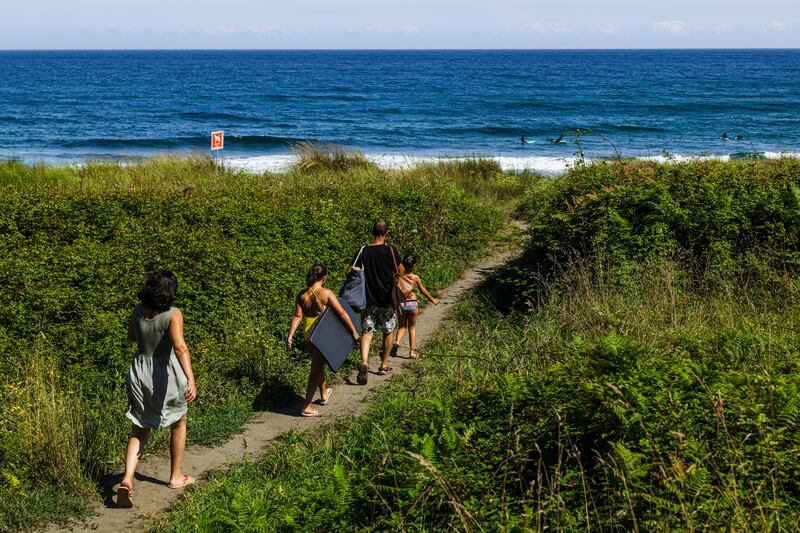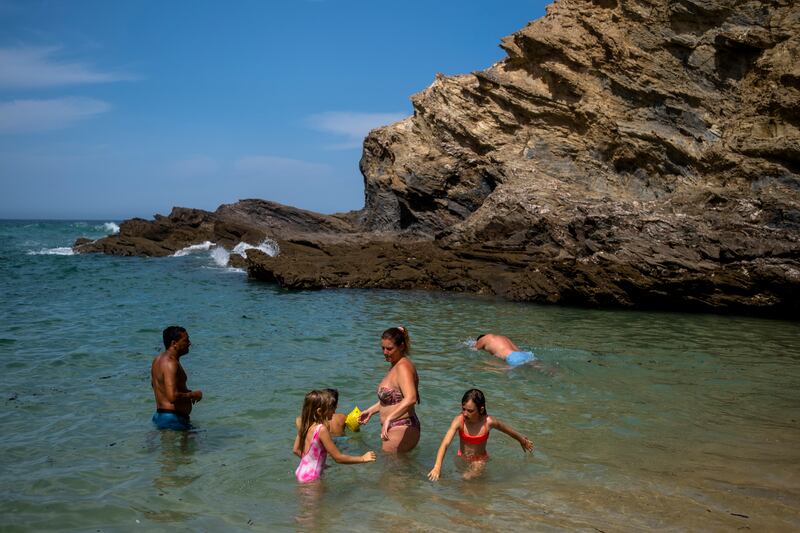What makes a great family beach? Clean water for swimming, clean sand for sitting, sunning, playing or walking, and naturally occurring amusements like gullies, tide pools or rocks for climbing. Access to decent food and bathrooms and even showers are also a plus and, thankfully, relatively common in Europe. And, of course, stunning scenery and nearby towns with lots of activities certainly help.
Below is a selection of my family’s personal favourites, from the calm, clear waters of Ålbæk, Denmark, to the white sands of Spain’s Balearic Islands.
Playa de Frejulfe
Asturias, Spain
Lush, verdant Asturias on Spain’s northern coast is the country’s dairy land, and since the less-fertile coastal areas were traditionally left uncultivated, there are fragrant pine (and, surprisingly, eucalyptus) forests that roll right up to the sand dunes of the region’s beaches.
Frejulfe beach in western Asturias is a sentimental favourite of ours as it is only about six minutes by car from my husband’s parents’ home near the town of Navia. For a decade, our kids only knew the broad crescent of the beach as the place where we’d bundle up in late December to walk off Christmas meals. But when the pandemic curtailed international travel, we got to experience the summer joys of Frejulfe – in bathing suits instead of coats and hats.
READ MORE
Like most Asturian beaches, Frejulfe comes with small waterfalls, caves and a narrow brackish river that snakes through the sand into the sea, giving smaller children who don’t like waves a safe place to frolic. Because of the neighbouring forests, there is always plenty of driftwood to construct elaborate tents adorned with beach towels.
Depending on the tides, rock formations at the cove’s edges provide fertile territory for spying anemones, starfish, crabs and the occasional tiny sea horse.
Some beaches, like nearby Fabal, are reached by steep staircases or precarious paths that would be hard, if not unsafe, for smaller children, but Frejulfe has easy access and a large car park, not to mention a bustling chiringuito (beach shack restaurant) and surf classes for older children.

Cap Ferret and Arcachon
France
Cap Ferret, a peninsula with a string of charm-forward hamlets tucked into the woods and dunes, has the wild Atlantic Ocean on one side and the more sheltered Bassin d’Arcachon (essentially a large bay) on the other. It offers everything you could want for a family beach holiday with French flair – winding lanes for biking, a wharf lined with seafood restaurants (the area is famous for oysters), a lighthouse and exquisite shops tucked amid the tree-shaded lanes selling stripy boatnecked shirts and vetiver-scented candles. All of it is wrapped in a ribbon of impeccably clean and broad golden sand beaches kissed by fresh Atlantic breezes.
Because we visited at Easter, when the weather could be less reliable, we stayed in Arcachon, a pretty belle époque resort town a delightful 15-minute ferry ride across the bay on the southern shore of the Bassin. Arcachon also scored with my children, especially the quirky, colourful art nouveau architecture and fabulous family-friendly restaurants. (“France is known for the best pizzas,” noted my food critic son, Freddie, as we sat down at Ragazzi da Peppone on Arcachon’s main drag.)
As we headed out of town on our return home, we stopped to climb the Dune du Pilat, a massive sand dune at the mouth of the Arcachon inlet. By far the tallest and largest “structure” in the area, it offers sweeping views of city, sea and forest – an area sadly devastated by recent wildfires. Upon seeing speck-like figures at the other end of the dune, my daughter, Frida, said, “It looks like the Great Wall of China,” and indeed it did.
Ålbæk Strand and Råbjerg Mile
Denmark
Massive dunes provide wonderful playgrounds for children who can climb them, roll down them or try futilely to run in the soft sand. Between Ålbæk and Skagen at the northern tip of Denmark is Råbjerg Mile, known to my family as “the wander dune,” because it is considered a “living” dune and is slowly drifting across the peninsula. Like the Pilat in Arcachon, its scale and as-far-as-the-eye-can-see extension are staggering.
There is nary a wave in the crystalline waters off the beach called Ålbæk Strand – just a couple of miles south of Råbjerg Mile and a perfect spot for young children to frolic in the sea. Being so shallow, the water, although still bracing, gets far warmer than one might expect in Scandinavia. And the beach seems to stretch for eternity, so there’s lots of nature to explore amid the dunes and woodlands. Ferries shuttling among Norway, Denmark and Sweden can be seen cruising across the horizon.
Parque Natural do Sudoeste Alentejano e Costa Vicentina
Portugal
In recent years, the jet set love affair with Comporta, the ever-chicer and ever-more-expensive summer destination south of Lisbon, has left the wilder Atlantic coast farther south largely overlooked. I was solo on my first visit to the area in 2007, and as I drove south toward Zambujeira do Mar, the coastal road kept offering such stunning glimpses of sandstone coves lapped by teal waters that I couldn’t help periodically pulling over for 10-minute swims off deserted beaches like Praia do Tonel.
I fell so hard for those beaches that we’ve now circled back twice, stopping in different places each time. Family-friendly beaches with parking and easy paths to the beach, perhaps even a lifeguard in season, include Praia do Carvajal and Praia de Odeceixe. Although other and newer accommodation options exist, we have a soft spot for the Herdade do Touril, a quaint farmhouse hotel with a great pool and a fabulous breakfast.

Ses Illetes
Formentera, Spain
An unexpected upside to the pandemic was our discovery of the joys of arriving to the beach by boat. In June 2020, with international vacation travel virtually banned around the globe, my husband realised that the economic laws of supply and demand for private boat rentals in the Mediterranean would be inverted (plenty of boats but few passengers), so we booked a trip that had always seemed too extravagant and hired a boat for a five-day cruise around Formentera, the smallest and most pristine of Spain’s Balearic Islands.
We boarded in Ibiza and within minutes of making the 20-minute crossing to Formentera, we were anchored and snorkelling in stunningly clear turquoise waters, elbowing each other underwater to point out schools of fish and the odd baby octopus. Eventually we walked up on shore, a strip of powdery white sand so narrow it took only minutes to cross, and re-entered the sea on the other side. There was nothing but nature surrounding us.
We took such a meandering route back to the boat that by the time we climbed aboard, nearly four hours had passed. As a child, I used to spend hours at a time in the ocean, but this was the first time my kids had done so, tirelessly swimming tremendous distances and then wanting to do it again after lunch.
That first stop, Ses Illetes, is typically (and deservedly) ranked the most beautiful beach in Formentera and often in all of Spain. A short boat ride south, there are restaurants like Beso Beach, famous, fun, delicious and wildly expensive, set in the dunes.
Some of the other island beaches are isolated smaller coves, but Formentera’s southern coast also provides a wide crescent of beautiful beaches. –This article originally appeared in The New York Times.













